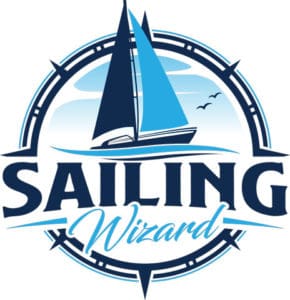It’s such a satisfying feeling when you discover a great anchorage. Perhaps you’re looking for a place to relax onboard to enjoy beautiful summer’s evening, or maybe you need to find somewhere to provide safe heaven for your yacht to wait out bad weather. But what makes a perfect anchorage?
A good example of a perfect anchorage would be an uncrowded bay, surrounded by cliffs or hills to provide protection from wind from most directions. Your anchorage should be free from hazards, with enough space for your vessel to swing at anchor with changes of wind direction and tidal stream.
Let’s take a look at ten essential factors you need to take into account when picking an anchorage.

How to Choose a Good Anchorage for Your Yacht
Here are some of my favourite tips that will help you to select the right anchorage for your needs.
1. Plan in Advance
Do your research before you set sail, so that you have picked an anchorage before you begin your passage. Leaving it to chance, and hoping to find a good anchorage when you want to stop, is never a good strategy!
Be sure to check the charts of the area you’re sailing in, as there may well be a few anchorage options already marked, for you to choose from. Pilotage guides, almanacs and other local guide books provide a wealth of helpful local information to help you choose a suitable anchorage.
There is also often lots of advice online from fellow sailors who have visited the area before you, and can share their local knowledge and anchorage advice. Cruising forums are great for this type of real-world practical advice.
2. Check the Weather Forecast
Of course, the suitability of any anchorage, and the safe haven it can provide, is very much dependent on the current (and forecast) weather conditions.
The current wind conditions and tidal stream may make a specific potential anchorage suitable. But if the wind is due to change direction and/or strength during the time you plan to stay at anchor, you will need to also assess the anchorage suitability based on those forecast conditions.
Another way to look at it, is that if weather conditions are due to deteriorate in the next few hours, you need to pick an anchorage which will provide your yacht with protection from this upcoming bad weather.
Think ahead!
3. Find Natural Protection
Look for an anchorage where the local geography will provide your yacht with protection from wind and waves in as may potential wind directions as possible.
Ideally, a bay or cove with cliffs or hills surrounding will provide a natural wind shadow, in multiple directions. Headlands, islands and other features will provide shelter from waves.
Consider which factors will most affect your comfort in the coming hours spent at anchor, and pick an anchorage which will best protect your yacht.
Be sure to bear in mind that as the tidal flow changes, the sea state may also change. For example changing from wind-with-tide, to wind-against-tide, will make the sea state more rough.
Avoid anchoring on a lee shore, or in a position which will become a lee shore as the forecast weather changes and/or worsens. Anchoring close to a lee shore will give you very little wiggle room if your anchor drags! You could find yourself in a dangerous situation fairly quickly.
4. Be Aware of Potential Hazards
It is of course important that you pick an anchorage which keeps you clear of potential hazards. To do so, you must both consult your charts, and do a proper visual survey of the potential anchoring area.
Check your charts and keep a lookout for dangerous features such as rocks, navigation buoys, moorings, and wires or chains laid on the seabed or riverbed.
Never anchor in a navigation channel, or in a position that may cause your yacht to swing into a channel as the wind or tidal conditions change.
Keep clear of other anchored or moored vessels, and take into account the radius that they will swing while at anchor. Remember that a boat on a swinging mooring will be likely to swing on a smaller radius that an anchored vessel.
If possible, it is often a good idea to anchor behind a group of one or more anchored yachts. That way you are less likely to swing into them as the tidal stream and/or wind changes direction.
5. Will You Have Enough Depth at Low Tide?
In tidal waters, the next few hours after anchoring will either be spent on a rising tide, or a falling tide.
Check the local tide tables to ensure that you know how much water you need to have beneath your keel at the time of anchoring, to ensure that at low tide you will still be clear of the bottom, and will not run aground. Make sure you’re well aware of the local tidal range, and whether you’re on a spring or neap tide.
On the other side of the same coin: if you plan to anchor close to low tide, and intend to stay long enough for the tide to rise significantly, you will need to make sure you let out enough anchor chain or warp to keep the desired anchor scope. This way your anchor will continue to hold as your yacht rises with the high tide.
6. Know What’s on The Bottom
Different types of anchor hold better in certain bottom conditions. For example, Danforth anchors perform very well in soft to medium bottom conditions such as mud and sand.
You should look for an anchorage with bottom conditions that suit the style of anchor you have on your yacht. Symbols such as M and S on your charts will inform you of what you will be dropping your anchor onto.
Try to avoid dropping anchor on sloping seabeds, or areas known to be covered in seagrass, as these will make it harder for your anchor to take hold.
Never anchor in coral. Not only is doing so illegal in many places, but it also causes significant environmental damage to important coral reef ecosystems. Coral heads also have the potential to foul your anchor chain or warp.
7. Be Aware of Other Vessels
As mentioned above, you must take the position of other vessels (both at those at anchor and moving) into account when picking a suitable place to anchor.
The importance of this type of situational awareness doesn’t stop once you’ve dropped anchor. Always keep an eye out for yachts moving in your immediate vicinity.
Don’t forget your obligation to display the appropriate signals, such as an anchor ball and anchor light, as per rule 30 of the International Regulations for the Prevention of Collision at Sea (COLREGS).
8. Have a Plan B
To be honest, having a fall-back plan is just good practice and should always be part of your passage planning.
What happens if the anchorage you had in mind is busy when you arrive, or if the sea state has changed?
Knowing that you have a Plan B will take a huge amount of stress out of this type of situation. It may be that you have a secondary anchorage already in mind, or a local marina that you can use as a last resort.
Either way, knowing that you have a plan for most reasonable “what ifs” is usually a comfort!
9. Arrive Before The Rush
In my experience, the best way to avoid needing to use your Plan B anchorage, is to arrive at your planned anchorage before everybody else who has had the same idea!
Whether it’s a popular lunchtime spot, or a well sheltered overnight anchorage, arriving ahead of the rush will make it easier to anchor in a low-stress situation.
If you know you’re visiting a popular bit of coastline, at a busy time of year, some additional research often pays dividends. A little time spent searching forums for local advice online can often unearth hidden gem anchorages, which will keep you away from the crowds.
10. Monitor Your Position at Anchor
In the interest of safety, and avoiding awkward situations with other anchored yachts, be sure to regularly monitor your position.
The low-tech way to do this is by taking visual transits, based on features on the shoreline and further inland. You can also take some quick fixes using a handheld bearing compass. Check these reference points regularly, and you’ll soon discover if your anchor is dragging.
If you have the facility to do so, be sure to set the anchor alarm on your chartplotter. However, even if the anchor alarm is on, it doesn’t remove your responsibility for maintaining awareness of your position.
More Tips for Finding a Safe Anchorage
Here’s a great video which will help you to position your boat properly when you get to your chosen anchorage.
Final Thoughts
Way too many cruising skippers seem nervous or hesitant to drop anchor, and instead head to the nearest crowded marina, missing out on some potentially beautiful stays at anchor.
I hope that the above check-list will give you the confidence to find an appropriate anchorage for your needs, whenever the situation arises.
Happy sailing!
